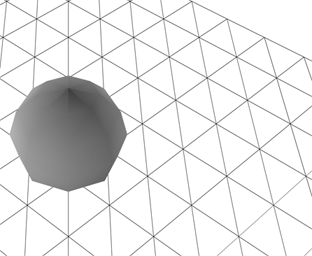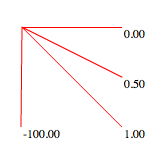XML:
-
<code>
-
<make reference="w" class="BasicView" args="stage.stageWidth, stage.stageHeight, false"/>
-
<call method="addChild" args="w"/>
-
-
<make reference="wireMat" class="WireframeMaterial" args="0x000000" />
-
-
<make reference="sphere" class="Sphere" args="wireMat, 100" />
-
-
<call method="w.scene.addChild" args="sphere" />
-
-
<make reference="animation" class="Object">
-
<set z="-500" rotationY="360" rotationX="360" ease="Back.easeOut"/>
-
</make>
-
-
<call method="TweenLite.to" args="sphere, 3, animation" />
-
-
<call method="setInterval" args="w.singleRender, 32" />
-
-
</code>
This snippet shows XML that the mini-library AsXML can read and run - in this case AsXML is set up to run with Papervision
A few days ago I had the idea to write some code that would run ActionScript based on XML. I spent some time getting rid of a few bugs and setting up some demos with TweenLite, Papervision and QuickBox2D. I wrapped everything up into a mini-library called AsXML.
Check out the demos here.

Download AsXML and demo files here.
AsXML Features:
1) call methods of the main timeline
2) read and write properties on the main timeline
3) instantiate classes on the main timeline
4) call methods on these classes
5) read and write properties on these classes
6) store references to return values from functions
Also posted in Box2D, Graphics, QuickBox2D, XML, dynamic, external data, instantiation, misc, motion, return values, string manipulation, strings | Tagged actionscript, as3, flash |
Actionscript:
-
/**
-
Original function by Pieter Iserbyt:
-
http://local.wasp.uwa.edu.au/~pbourke/geometry/pointline/DistancePoint.java
-
from Paul Bourke's website:
-
http://local.wasp.uwa.edu.au/~pbourke/geometry/pointline/
-
*/
-
function pointToLineDist(x1:Number, y1:Number, x2:Number, y2:Number,x3:Number, y3:Number):Number {
-
var dx:Number=x2-x1;
-
var dy:Number=y2-y1;
-
if (dx==0&&dy==0) {
-
x2+=1;
-
y2+=1;
-
dx=dy=1;
-
}
-
var u:Number = ((x3 - x1) * dx + (y3 - y1) * dy) / (dx * dx + dy * dy);
-
-
var closestX:Number;
-
var closestY:Number;
-
if (u<0) {
-
closestX=x1;
-
closestY=y1;
-
} else if (u> 1) {
-
closestX=x2;
-
closestY=y2;
-
} else {
-
closestX=x1+u*dx;
-
closestY=y1+u*dy;
-
}
-
dx=closestX-x3;
-
dy=closestY-y3;
-
return Math.sqrt(dx * dx + dy * dy);
-
}
-
-
/**
-
Test out the function
-
*/
-
-
var dotA:Sprite = dot(100, 100);
-
var dotB:Sprite = dot(200, 200);
-
var dotC:Sprite = dot(150, 100, 0x0000FF);
-
var txt:TextField = TextField(dotC.addChild(new TextField()));
-
with(txt) x = 5, y = 5, autoSize = "left", selectable = false, mouseEnabled = false;
-
-
addEventListener(Event.ENTER_FRAME, onLoop);
-
function onLoop(evt:Event):void {
-
graphics.clear();
-
graphics.lineStyle(0,0x000000);
-
graphics.moveTo(dotA.x, dotA.y);
-
graphics.lineTo(dotB.x, dotB.y);
-
txt.text = pointToLineDist(dotA.x, dotA.y, dotB.x, dotB.y, dotC.x, dotC.y).toFixed(2);
-
}
-
-
// draggable dot
-
function dot(xp:Number, yp:Number, col:uint = 0xFF0000, rad:Number=4):Sprite {
-
var s:Sprite = Sprite(addChild(new Sprite));
-
s.x = xp;
-
s.y = yp;
-
with(s.graphics) beginFill(col), drawCircle(0,0,rad);
-
s.buttonMode = true;
-
s.addEventListener(MouseEvent.MOUSE_DOWN, onDrag);
-
return s;
-
}
-
function onDrag(evt:MouseEvent):void { evt.currentTarget.startDrag() }
-
stage.addEventListener(MouseEvent.MOUSE_UP, onUp);
-
function onUp(evt:MouseEvent):void{stopDrag() }
This is the same as yesterdays post about the distance between a point and a line segment. I just took a few minutes to optimize the function - it runs close to 3X faster now. For more info see yesterdays post.
Actionscript:
-
/**
-
Original function by Pieter Iserbyt:
-
http://local.wasp.uwa.edu.au/~pbourke/geometry/pointline/DistancePoint.java
-
from Paul Bourke's website:
-
http://local.wasp.uwa.edu.au/~pbourke/geometry/pointline/
-
*/
-
function pointToLineDistance(p1:Sprite, p2:Sprite, p3:Sprite):Number {
-
var xDelta:Number = p2.x - p1.x;
-
var yDelta:Number = p2.y - p1.y;
-
if ((xDelta == 0) && (yDelta == 0)) {
-
// p1 and p2 cannot be the same point
-
p2.x += 1;
-
p2.y += 1;
-
xDelta = 1;
-
yDelta = 1;
-
}
-
var u:Number = ((p3.x - p1.x) * xDelta + (p3.y - p1.y) * yDelta) / (xDelta * xDelta + yDelta * yDelta);
-
var closestPoint:Point;
-
if (u <0) {
-
closestPoint = new Point(p1.x, p1.y);
-
} else if (u> 1) {
-
closestPoint = new Point(p2.x, p2.y);
-
} else {
-
closestPoint = new Point(p1.x + u * xDelta, p1.y + u * yDelta);
-
}
-
return Point.distance(closestPoint, new Point(p3.x, p3.y));
-
}
-
-
/**
-
Test out the function
-
*/
-
-
var dotA:Sprite = dot(100, 100);
-
var dotB:Sprite = dot(200, 200);
-
var dotC:Sprite = dot(150, 100, 0x0000FF);
-
var txt:TextField = TextField(dotC.addChild(new TextField()));
-
with(txt) x = 5, y = 5, autoSize = "left", selectable = false, mouseEnabled = false;
-
-
addEventListener(Event.ENTER_FRAME, onLoop);
-
function onLoop(evt:Event):void {
-
graphics.clear();
-
graphics.lineStyle(0,0x000000);
-
graphics.moveTo(dotA.x, dotA.y);
-
graphics.lineTo(dotB.x, dotB.y);
-
txt.text = pointToLineDistance(dotA, dotB, dotC).toFixed(2);
-
}
-
-
// draggable dot
-
function dot(xp:Number, yp:Number, col:uint = 0xFF0000, rad:Number=4):Sprite {
-
var s:Sprite = Sprite(addChild(new Sprite));
-
s.x = xp;
-
s.y = yp;
-
with(s.graphics) beginFill(col), drawCircle(0,0,rad);
-
s.buttonMode = true;
-
s.addEventListener(MouseEvent.MOUSE_DOWN, onDrag);
-
return s;
-
}
-
function onDrag(evt:MouseEvent):void { evt.currentTarget.startDrag() }
-
stage.addEventListener(MouseEvent.MOUSE_UP, onUp);
-
function onUp(evt:MouseEvent):void{stopDrag() }
Last night I was working late and found myself in need of a way to calculate the distance between a point and a line. After a quick google search I found myself once again on Paul Bourke's extremely useful website. I was in a rush, so I just quickly ported the java code (by Pieter Iserbyt) and wrote this test snippet to make sure it works.
This code could be optimized a bit, but it works nicely.
I needed this for a commercial project, but as I was porting the code I thought of an interesting way to use this code to draw a gradient - may write and post that tomorrow.
Actionscript:
-
// calculate the slope of a line
-
function calculateSlope(x1:Number, y1:Number, x2:Number, y2:Number):Number {
-
// rise over run
-
var s:Number = (y1 - y2) / (x1 - x2);
-
/*if (x1==x2) {
-
// slope is Infinity or -Infinity
-
}*/
-
return s;
-
}
-
-
/**
-
Test it out
-
*/
-
function draw(x1:Number, y1:Number, x2:Number, y2:Number):void {
-
graphics.moveTo(x1, y1);
-
graphics.lineTo(x2, y2)
-
var txt:TextField =TextField(addChild(new TextField()));
-
txt.text = calculateSlope(x1, y1, x2, y2).toFixed(2);
-
txt.x = x2, txt.y = y2;
-
}
-
-
graphics.lineStyle(0,0xFF0000);
-
draw (100, 100, 200, 200);
-
-
draw(100, 100, 200, 150);
-
-
draw(100, 100, 200, 100);
-
-
draw(100, 100, 99, 200);
This snippet shows how to calculate the slope of a line ... It demos the function by drawing a few lines and showing the corresponding slope of each.
It will draw this:

If (x1 == x2), the slope will be -Infinity or Infinity... depending on where you're using this calculation you may want to reset the s variable to something else, return null etc... I commented it out for simplicity.
Also posted in misc | Tagged actionscript, as3, flash |

